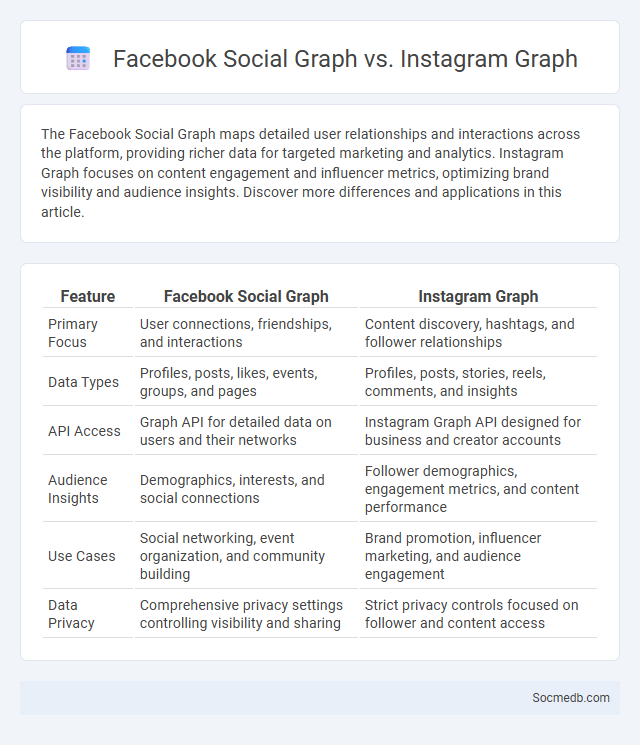
Photo illustration: Facebook Social Graph vs Instagram Graph
The Facebook Social Graph maps detailed user relationships and interactions across the platform, providing richer data for targeted marketing and analytics. Instagram Graph focuses on content engagement and influencer metrics, optimizing brand visibility and audience insights. Discover more differences and applications in this article.
Table of Comparison
| Feature | Facebook Social Graph | Instagram Graph |
|---|---|---|
| Primary Focus | User connections, friendships, and interactions | Content discovery, hashtags, and follower relationships |
| Data Types | Profiles, posts, likes, events, groups, and pages | Profiles, posts, stories, reels, comments, and insights |
| API Access | Graph API for detailed data on users and their networks | Instagram Graph API designed for business and creator accounts |
| Audience Insights | Demographics, interests, and social connections | Follower demographics, engagement metrics, and content performance |
| Use Cases | Social networking, event organization, and community building | Brand promotion, influencer marketing, and audience engagement |
| Data Privacy | Comprehensive privacy settings controlling visibility and sharing | Strict privacy controls focused on follower and content access |
Introduction to Social Graphs
Social graphs map the relationships and interactions between individuals or entities across social media platforms, revealing patterns of connectivity and influence. Understanding your social graph helps identify key connections, engagement levels, and community clusters that drive content reach and user behavior. Leveraging social graph insights enables targeted marketing strategies and enhances personalized user experiences.
What is the Facebook Social Graph?
The Facebook Social Graph represents the network of connections between users, their interests, and the content they interact with, forming a comprehensive map of social relationships and data. It enables personalized experiences by analyzing your interactions, friendships, likes, and shared content to deliver tailored news feeds and targeted advertising. This dynamic graph continually evolves as you engage with posts, pages, and other users, driving Facebook's social algorithms.
Understanding the Instagram Graph
The Instagram Graph API enables businesses and developers to access and manage their Instagram professional accounts programmatically, providing detailed insights such as follower demographics, engagement metrics, and content performance. It supports features like publishing posts, retrieving comments, and moderating interactions to enhance user engagement and brand presence. Understanding the Instagram Graph API is essential for optimizing marketing strategies and automating social media management through data-driven decision-making.
Defining the General Social Graph
The general social graph maps the complex web of connections among individuals, organizations, and entities across various social media platforms. It encompasses relationships based on interactions, shared content, and mutual interests, enabling detailed social network analysis. Understanding Your position within this graph is essential for leveraging social media to build meaningful connections and increase influence effectively.
Key Differences Between Facebook and Instagram Social Graphs
Facebook's social graph centers on comprehensive user connections, including friends, family, groups, and pages, emphasizing real-life relationships and extended networks. Instagram's social graph prioritizes visual content interactions, focusing on followers and engagement through likes, comments, and shares primarily within interest-based communities. Facebook supports bidirectional friendships, while Instagram follows a predominantly unidirectional follower model, shaping different digital social dynamics and user experiences.
Data Structures and API Access Comparison
Social media platforms utilize diverse data structures such as graphs to model user connections and time-series databases for content feeds, optimizing data retrieval and interaction. APIs vary significantly in access levels, with RESTful APIs offering broad, stateless requests, while GraphQL APIs provide flexible, client-defined queries enhancing efficiency in data fetching. Comparing access, platforms like Twitter expose extensive endpoints for tweets and user data, whereas Instagram's API is more restrictive, focusing on user media and engagement metrics, influencing integration capabilities.
Privacy and Security in Social Graphs
Social graphs on social media platforms encapsulate intricate networks of your relationships and interactions, making privacy and security critical concerns. Implementing robust encryption, access controls, and transparent data policies safeguards your personal information from unauthorized access and misuse. Constant vigilance over your sharing settings and understanding the platform's data practices empower you to maintain control over your digital social footprint.
Impact on User Engagement and Experience
Social media platforms significantly enhance user engagement by providing interactive features such as likes, shares, and comments that foster real-time communication and community building. Your experience is personalized through advanced algorithms that tailor content to individual preferences, increasing relevance and time spent on these platforms. High-quality visuals, trending topics, and instant notifications further immerse users, driving continuous interaction and satisfaction.
Social Graphs in Marketing and Analytics
Social graphs map the relationships and interactions between users on social media platforms, providing valuable insights for marketing and analytics. By analyzing social graphs, marketers can identify influential users, track engagement patterns, and optimize campaign targeting to boost brand visibility and reach. Understanding your audience's social connections allows you to tailor strategies that enhance customer engagement and drive measurable business growth.
Future Trends of Social Graph Technology
Future trends in social graph technology emphasize enhanced AI-driven relationship mapping and real-time interaction analytics to improve personalization. Integration of decentralized networks aims to increase user control over data and privacy while fostering more transparent connections. Advances in augmented reality (AR) and virtual reality (VR) will create immersive social experiences, further evolving how social graphs represent and facilitate human interactions.
 socmedb.com
socmedb.com